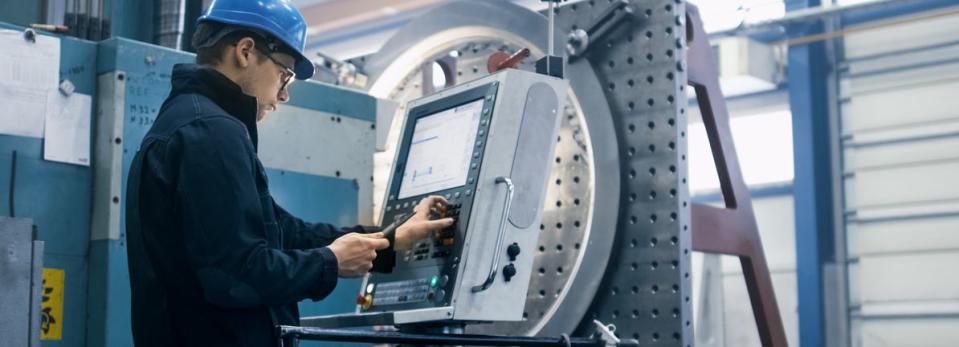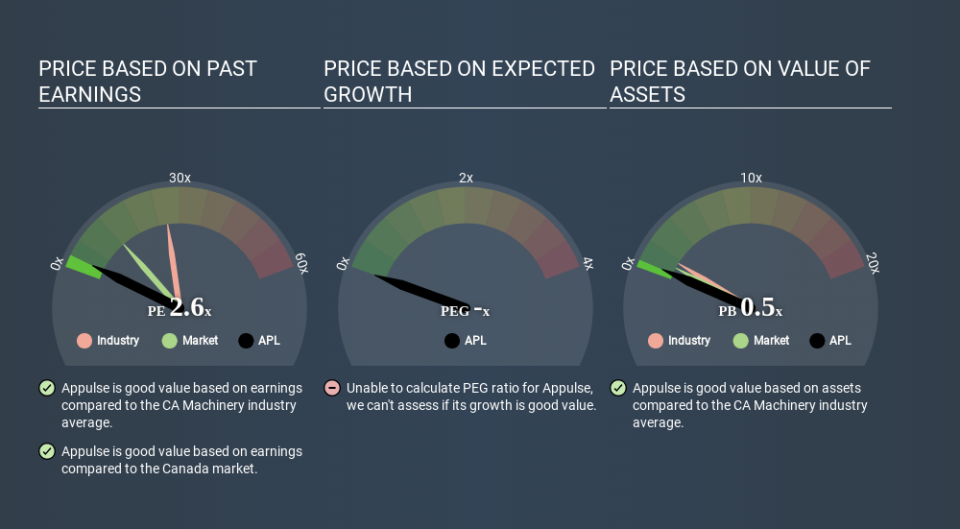What Is Appulse's (CVE:APL) P/E Ratio After Its Share Price Rocketed?

Appulse (CVE:APL) shareholders are no doubt pleased to see that the share price has had a great month, posting a 50% gain, recovering from prior weakness. Longer term shareholders are no doubt thankful for the recovery in the share price, since it's pretty much flat for the year, even after the recent pop.
Assuming no other changes, a sharply higher share price makes a stock less attractive to potential buyers. In the long term, share prices tend to follow earnings per share, but in the short term prices bounce around in response to short term factors (which are not always obvious). The implication here is that deep value investors might steer clear when expectations of a company are too high. One way to gauge market expectations of a stock is to look at its Price to Earnings Ratio (PE Ratio). A high P/E ratio means that investors have a high expectation about future growth, while a low P/E ratio means they have low expectations about future growth.
View our latest analysis for Appulse
Does Appulse Have A Relatively High Or Low P/E For Its Industry?
We can tell from its P/E ratio of 2.62 that sentiment around Appulse isn't particularly high. If you look at the image below, you can see Appulse has a lower P/E than the average (26.0) in the machinery industry classification.
Its relatively low P/E ratio indicates that Appulse shareholders think it will struggle to do as well as other companies in its industry classification. Since the market seems unimpressed with Appulse, it's quite possible it could surprise on the upside. If you consider the stock interesting, further research is recommended. For example, I often monitor director buying and selling.
How Growth Rates Impact P/E Ratios
Probably the most important factor in determining what P/E a company trades on is the earnings growth. If earnings are growing quickly, then the 'E' in the equation will increase faster than it would otherwise. That means unless the share price increases, the P/E will reduce in a few years. And as that P/E ratio drops, the company will look cheap, unless its share price increases.
In the last year, Appulse grew EPS like Taylor Swift grew her fan base back in 2010; the 404% gain was both fast and well deserved. The sweetener is that the annual five year growth rate of 39% is also impressive. So I'd be surprised if the P/E ratio was not above average.
A Limitation: P/E Ratios Ignore Debt and Cash In The Bank
The 'Price' in P/E reflects the market capitalization of the company. That means it doesn't take debt or cash into account. In theory, a company can lower its future P/E ratio by using cash or debt to invest in growth.
Such expenditure might be good or bad, in the long term, but the point here is that the balance sheet is not reflected by this ratio.
How Does Appulse's Debt Impact Its P/E Ratio?
Net debt is 37% of Appulse's market cap. While it's worth keeping this in mind, it isn't a worry.
The Verdict On Appulse's P/E Ratio
Appulse has a P/E of 2.6. That's below the average in the CA market, which is 12.1. The EPS growth last year was strong, and debt levels are quite reasonable. If the company can continue to grow earnings, then the current P/E may be unjustifiably low. What we know for sure is that investors are becoming less uncomfortable about Appulse's prospects, since they have pushed its P/E ratio from 1.7 to 2.6 over the last month. If you like to buy stocks that could be turnaround opportunities, then this one might be a candidate; but if you're more sensitive to price, then you may feel the opportunity has passed.
Investors should be looking to buy stocks that the market is wrong about. As value investor Benjamin Graham famously said, 'In the short run, the market is a voting machine but in the long run, it is a weighing machine. Although we don't have analyst forecasts you could get a better understanding of its growth by checking out this more detailed historical graph of earnings, revenue and cash flow.
But note: Appulse may not be the best stock to buy. So take a peek at this free list of interesting companies with strong recent earnings growth (and a P/E ratio below 20).
If you spot an error that warrants correction, please contact the editor at editorial-team@simplywallst.com. This article by Simply Wall St is general in nature. It does not constitute a recommendation to buy or sell any stock, and does not take account of your objectives, or your financial situation. Simply Wall St has no position in the stocks mentioned.
We aim to bring you long-term focused research analysis driven by fundamental data. Note that our analysis may not factor in the latest price-sensitive company announcements or qualitative material. Thank you for reading.

 Yahoo Finance
Yahoo Finance 
